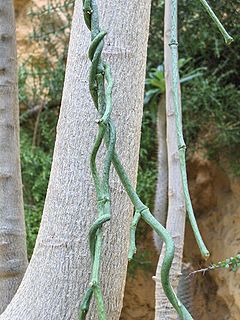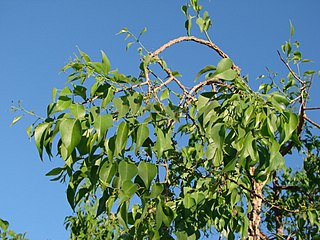
Cynanchum is a genus of about 300 species including some swallowworts, belonging to the family Apocynaceae. The taxon name comes from Greek kynos and anchein, hence the common name for several species is dog-strangling vine. Most species are non-succulent climbers or twiners. There is some evidence of toxicity.

Agonandra is a genus of plants in the family Opiliaceae described as a genus in 1862.

Oxypetalum is a genus of flowering plants in the family Apocynaceae, first described with this name in 1810. The genus is native to South America.

Stromanthe is a genus of flowering plants in the family Marantaceae, native to the tropical portions of the Americas from Mexico to Trinidad to northern Argentina.

Araujia is a small genus of perennial vines in the dogbane family first described as a genus in 1817. The group is native to South America.
- Araujia angustifolia(Hook. & Arn.) Steud. - Brazil, Paraguay, Uruguay, NE Argentina
- Araujia graveolens(Lindl.) Mast. - Brazil
- Araujia herzogii(Schltr.) Fontella & Goyder - Bolivia
- Araujia hortorumE.Fourn. - Brazil, Paraguay, Uruguay, NE Argentina
- Araujia megapotamica(Spreng.) G.Don - Brazil, Uruguay, NE Argentina
- Araujia plumosaSchltr. - Brazil, Paraguay, Bolivia, NW Argentina
- Araujia sericiferaBrot. - white bladderflower, cruel vine - Peru, Brazil; naturalized in parts of South Africa + United States
- Araujia stuckertiana(Kurtz ex Heger) Fontella & Goyder - Cordoba in Argentina
- Araujia subhastataE.Fourn. - Brazil

Funastrum is a genus of flowering plant now in the family Apocynaceae. The name is derived from the Latin word funis, meaning "rope", and astrum, alluding to the twining stems. Members of the genus are commonly known as twinevines.
Tweedia is a genus of flowering plants in the family Apocynaceae, first described as a genus in 1835. The genus is native to South America. An ornamental plant, Oxypetalum coeruleum, formerly included in this genus is commonly referred to as "tweedia".
- Tweedia andina(Phil.) G.H.Rua - Chile
- Tweedia aucaensisG.H. Rua - Argentina
- Tweedia australis(Malme) C. Ezcurra - Argentina
- Tweedia birostrata(Hook. & Arn.) Hook. & Arn. - Chile
- Tweedia brunonisHook. & Arn. - Argentina, Bolivia, Paraguay
- Tweedia echegarayi(Hieron.) Malme - Argentina
- Tweedia solanoides(Hook. & Arn.) Chittenden - Argentina, Brazil, Paraguay, Uruguay

Orthosia is a genus of plants in the family Apocynaceae, first described as a genus in 1844.

Fischeria is a plant genus in the family Apocynaceae, first described as a genus in 1813. It is native to South America, Central America, southern Mexico, and the West Indies.
Telminostelma is a genus of plants in the Apocynaceae, first described as a genus in 1885. It is native to Brazil and Bolivia in South America.
- Telminostelma foetidum(Cav.) Fontella & E.A.Schwarz - Chuquisaca region in Bolivia
- Telminostelma roulinioidesE. Fourn. - Brazil
- Telminostelma carautanum, syn of Cynanchum carautanum
- Telminostelma corymbosum, syn of Cynanchum blandum
- Telminostelma ekmanii, syn of Cynanchum caudiculatum
Tassadia is a genus of plants in the family Apocynaceae, first described as a genus in 1844. It is native primarily to South America, with one species extending north into Central America, S Mexico, and Trinidad.

Barjonia is a genus of flowering plants in the family Apocynaceae, first described as a genus in 1844. They are native to South America.
Minaria is a genus of flowering plants in the family Apocynaceae, first described as a genus in 2006. They are native to Brazil and Bolivia in South America.
Nephradenia is a genus of plants in the family Apocynaceae, first described as a genus in 1844. They are native to South America.

Macroditassa is a genus of plant in family Apocynaceae, first described as a genus in 1927. It is native to South America.

Ditassa is a genus of plant in the family Apocynaceae, first described as a genus in 1810. It is native to South America.
Jobinia is a genus of flowering plants of the family Apocynaceae first described in 1885. It is native to South America and Central America.
Melinia is a genus of plants in the family Apocynaceae, first described as a genus in 1835. It was initially given the name Brachylepis, but this turned out to be an illegitimate homonym, meaning that someone else had already used the name for a different plant. Melinia is native to South America.
- Melinia eichleri(E. Fourn.) K. Schum. - Brazil
- Melinia peruvianaSchltr. - Ayacucho in Peru
- Melinia volcanenseKrapov. & S. Cáceres - Jujuy Province in NW Argentina

Peplonia is a group of plants in the family Apocynaceae first described as a genus in 1844. The entire genus is endemic to Brazil.
- Peplonia asteria(Vell.) Fontella & E.A. Schwarz - Brazil
- Peplonia axillaris(Vell.) Fontella & Rapini - Brazil
- Peplonia bradeana(Fontella & E.A. Schwarz) Fontella & Rapini - Espírito Santo
- Peplonia hatschbachii(Fontella & de Lamare) Fontella & Rapini - Paraná
- Peplonia hilarianaE.Fourn. - Brazil
- Peplonia nitidaDecne. - Brazil
- Peplonia organensis(E.Fourn.) Fontella & Rapini - Brazil
- Peplonia riedelii(E.Fourn.) Fontella & Rapini - Rio de Janeiro
Hemipogon is a genus of flowering plants in the family Apocynaceae, first described as a genus in 1844. It is native to South America.











